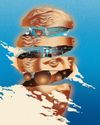
“Oranges, reds, yellows… a kaleidoscope of colour. It was like walking in the Alps in autumn. Truly amazing.” Israeli geologist Boaz Langford is describing one of the vast caverns in Dark Star – a huge cave system tucked inside the BaisunTau mountain range in an isolated region of Uzbekistan. Langford was part of the international team of scientists and cavers who explored the system in 2014.
“In another branch there are frozen lakes; elsewhere, huge waterfalls. The variety of sights is incredible. Every area is different. Dark Star is like no other. Totally unusual. I’m a scientist, and not very religious, but there is something spiritual about that place.”
Political instability and its remote location have kept the depths of Dark Star (named after a 1974 sci-fi comedy film) hidden from human eyes. But in 1990, a British team managed to reach one of the entrances, and so exploration of this dark underworld began. Around 17km of passages, along with additional entrances, have since been discovered, but all of the openings sit halfway up a 200m-high limestone cliff. And just getting to the base camp at its foot is a long and treacherous journey. Langford and his colleagues met the rest of the expedition team in the Uzbek capital Tashkent. Loading all their equipment onto a bus, they drove 160km along part of the ancient Silk Road towards Samarqand, before switching to a six-wheeled truck and heading south across arid plains in the direction of the Baisun district on the Afghan border. At the foot of the Baisun-Tau mountain range, they ditched the truck and continued on foot for two days, with donkeys lugging their gear.
هذه القصة مأخوذة من طبعة September/October 2021 من Very Interesting.
ابدأ النسخة التجريبية المجانية من Magzter GOLD لمدة 7 أيام للوصول إلى آلاف القصص المتميزة المنسقة وأكثر من 9,000 مجلة وصحيفة.
بالفعل مشترك ? تسجيل الدخول
هذه القصة مأخوذة من طبعة September/October 2021 من Very Interesting.
ابدأ النسخة التجريبية المجانية من Magzter GOLD لمدة 7 أيام للوصول إلى آلاف القصص المتميزة المنسقة وأكثر من 9,000 مجلة وصحيفة.
بالفعل مشترك? تسجيل الدخول

TAKE IT SLOW
Slow running is a fitness trend with some hard and fast science behind it

Physics, AI and music share a common thread. You just have to know where to look
Studying science can lead you in many directions and open doors to unexpected possibilities along the way

BED BUGS VS THE WORLD
When bloodthirsty bed bugs made headlines for infesting Paris Fashion Week in 2023, it shone a spotlight on a problem that's been making experts itch for decades: the arms race going on between bed bugs and humans

Kids are the key to understanding obesity. But we need more of their genes...
We can unravel the role that bodyweight plays in disease, but we need a bigger, more diverse, sample of genetic material to do so

COVID inquiry: What did we learn and what can we do better in future pandemics?
Masks, social distancing, lockdowns... how effective was the UK's response to the COVID-19 pandemic?

One hormone could be the key that unlocks a cure for morning sickness
The nausea and vomiting that, in extreme cases, can endanger mothers and babies might soon be just a memory

THE WORLD'S WEIRDEST CREATURES
Under the sea and upon the land, some animals look - to us - pretty strange...

WHEN MIND AND MACHINE COLLIDE
First, Elon Musk wanted to make electric cars ubiquitous, then he wanted to make space exploration a private enterprise. Now, with Neuralink, his newest venture, Musk hopes to merge humans and artificial intelligence. Turns out, it might not be such a crazy idea...

COME OUT OF YOUR SHELL
Social anxiety is more than just being shy. It's a phobia born out of our evolutionary past. But that raises a puzzling question: why do so many of us fear human interaction when we're supposed to be the most sociable species on the planet?

SPACE ODDITIES
Take a tour of the weirdest spots in the universe, where the 'normal' rules don't apply. Places that squeeze time, blow bubbles and even rain glass... sideways